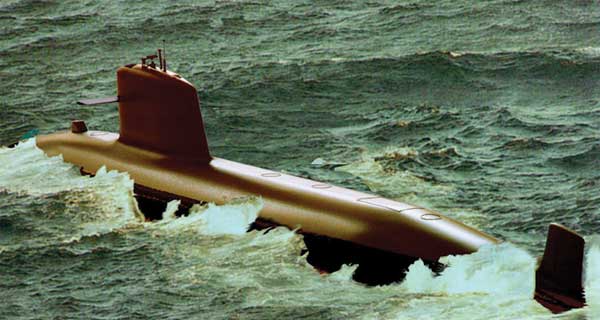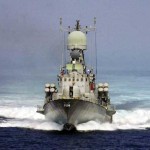“Of all the branches of men in the forces there is none which shows more devotion and faces grimmer perils than the submariners.” — Sir Winston S. Churchill
The development of the self propelled torpedo and the submerged diesel engine run by powerful storage batteries resulted in the creation of what modern navies call submarines. They let loose a trial of terror and destruction in both the World Wars. The submarines came into limelight during the earlier years of this century and gained considerable notoriety by wreaking havoc upon Allied merchant and naval shipping during World War I.
The evolution of the significance of submarines led to the belief, “there are only two kinds of naval vessels – submarines, and targets.” The submarine is a formidable weapon system and without a submarine no navy in this world can be considered complete. The Second World War witnessed the reaffirmation of the submarine’s role as an offensive force at sea. During the Second World War the battleships were replaced by the aircraft carriers as ‘queen of the seas’1 due to their ability to support a fleet and aircraft operations, far ashore. The second half of the twentieth century has witnessed nations clamoring for submarines in addition to traditional battleships. By 2000, the traditional diesel submarines had lost its presence by the massive introduction of the nuclear submarines.
The Indian Navy and Submarines
Pre World War II, the Royal Indian Navy (RIN) had a very limited role as a defence force and was restricted to coastal defence only. During the Second World War, the British expanded the RIN and changed its role from a coastal defence force with an offensive role. During the period 1939-1945, RIN underwent a phenomenal expansion. Still, the proposal to acquire a submarine for the Indian Navy was discouraged by the British naval officers who were then still in commanding positions in the Indian Navy , on the grounds that the sophisticated technology and the skills required to operate submarines were beyond the capability of the Indians2.
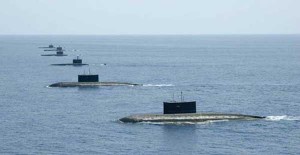 When India attained independence, its officers and men who had seen the havoc caused by submarines in the North Atlantic, first hand, pressed for the creation of a submarine arm. But it took several years before the plunge was taken. In post independence period the political leaders never felt the importance of the development of Navy; in other words, they never expect any threat from sea. India could never think of a belligerent neighbour except Pakistan which did not have any developed Navy as well.
When India attained independence, its officers and men who had seen the havoc caused by submarines in the North Atlantic, first hand, pressed for the creation of a submarine arm. But it took several years before the plunge was taken. In post independence period the political leaders never felt the importance of the development of Navy; in other words, they never expect any threat from sea. India could never think of a belligerent neighbour except Pakistan which did not have any developed Navy as well.
The Nehruvian Government with its focus on the agrarian sector never wanted to spend a major share of annual budget for the defence. Secondly the Western powers did not want India to possess such a formidable weapon. The British officers wanted the Indian Navy as a small force in a coastal defence role and the Royal Navy to continue to be responsible for overall oceanic and maritime defence of India.
In 1948, due to budgetary constraints, the Navy was asked to recast its requirements. The Navy’s
ten year plan 1948 – 1958 gave lesser priority to the Submarine Arm because it could not be created by 1958. In 1951, since large scale naval expansion could not be afforded, the Navy proposed a ship replacement programme instead of a ship acquisition programme. There was no plan to acquire a submarine in this plan. By 1956 the Indian Navy realized the importance of upgradation of the Navy, because of Pakistan’s admission into CENTO and SEATO and was consequently to be given extensive naval assistance by the Americans and Britain.
As a result, in one of the appreciations of the future naval requirements for India and Pakistan is the early 1950’s, the British Admiralty said that it was in the interest of the Commonwealth as a whole that India and Pakistan should maintain such naval forces as could be supported by their resources in material, manpower and finance and that the functions of these naval forces in war would primarily be to provide for the security of India and Pakistan including provision for harbour defence, minesweeping and coastal convoys, and secondarily, to contribute to the overall security of the British Commonwealth. This would also include a share in the control of sea communications in the Indian Ocean, particularly in the Arabian Sea and the Bay of Bengal3.
In addition to the arguments used earlier, it was emphasised that China possessed submarines, some of which had sufficient range to operate in the Bay of Bengal.
The proposal to form a Submarine Arm was taken up in earnest for the first time in 1959. The initial proposal envisaged the acquisition of four submarines from the Royal Navy at a cost of Rs 16 crores, with a recurring cost of Rs 2 crores annually for operation and maintenance. The preamble and the plans paper on the ‘Outline Plan for the Reorganisation and Development of the Royal Indian Navy’ prepared by the Naval Headquarters immediately after the independence mentioned, “The Navy and Army of India as united have existed for over 300 years. The Army on the date of partition numbered some 480,000 men and was fully equipped as a modern fighting machine. The Royal Indian Air Force had existed for only ten years but at the date of partition possessed some 11 squadrons of aircraft. The Navy by contrast, possessed but a handful of small ships4.”
“A submarine is an integral part of a maritime force… In a local or global war in which India may be forced to take part, submarines can be employed in enemy controlled waters and in strikes against hostile ships on the high seas and in harbour. Submarines are one of the most effective means of blockading the enemy’s seaborne trade…..” The statement mentioned the possible uses of submarine against submarines, as radar pickets, and even as aircraft control ships for providing valuable early information. Concluding the argument, the proposal recommended, “In order to develop a fully integrated maritime force, the Indian Navy should make an early start in establishing a Submarine Arm of its own. The important thing is to acquire the technique of operating submarines as early as possible, and for the purpose, a start with conventional or old submarines will provide and adequate answer.”
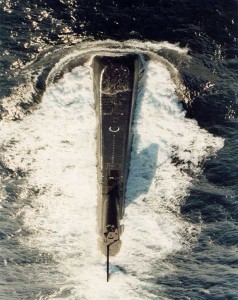 According to Admiral AK Chatterji “the long delay in acquiring a submarine was due firstly, to the lack of funds allotted to the Navy as the Government considered the Navy to be a less important service in the face of threats on land; and secondly, the unwillingness of USA and Britain to let us have a submarine on suitable terms.”5
According to Admiral AK Chatterji “the long delay in acquiring a submarine was due firstly, to the lack of funds allotted to the Navy as the Government considered the Navy to be a less important service in the face of threats on land; and secondly, the unwillingness of USA and Britain to let us have a submarine on suitable terms.”5
“The British were adamant in their views that submarines were sophisticated weapon systems which were difficult to operate, that the Indian Navy was still too young to venture into the submarine field, that submarines were accident prone, that the loss of a submarine at sea would lead to the loss of confidence in the Navy at Governmental and national level which would gravely impair the Navy’s further development”6.
During all these years, there had been no progress on the acquisition of submarines. According to Vice Adm Hiranandani, there were several weighty reasons. “Until 1956, the Navy itself was fully stretched, personnel wise and budget wise, in remedying the after-effects of the partition of the Royal Indian Navy. Ships and aircraft were being acquired and training, repair and logistic facilities were being set up ashore. After 1956, the Navy’s efforts were primarily focused on acquiring ships and aircraft to cope with the increased threat from Pakistan. The Navy found it extremely difficult to carry conviction, either in India or in Britain, that the Submarine Arm was a priority requirement. In the context of a non- violent, peace-loving member of the British Commonwealth whose overriding priority was economic development, nobody was prepared to accept that India at all needed a patently offensive Submarine Arm”7.
India had wanted an Oberon or Porpoise class submarine from the Admiralty, however, the latter was prepared to offer only obsolescent ‘A’ class submarines of Second World War vintage. The decision on the acquisition of Russian submarines thus marked an end of an era for the Indian Navy in several ways8.
The proposal to establish a submarine arm continued to be in a state of limbo, ostensibly owing to lack of finances, but it suddenly acquired urgency with the arrival of the new frigates with anti-submarine capability, mainly because it had been reported in 1958 that a neighbouring country was considering the acquisition of submarines for its navy.
In a proposal on the subject submitted in 1958, Naval Headquarters stated that there was an urgent need for augmenting the facilities available in the Navy for the anti-submarine training of surface ships with live submarine targets and unless this could be achieved, the efficiency of the Navy in anti-submarine warfare would remain low. It added that the acquisition of modern ships fitted with the latest anti-submarine equipment did not by itself constitute an efficient anti-submarine force for, among other things; it required a high degree of sustained and continuous training with live submarines under realistic conditions.
Admiral Chatterji states “A paper was submitted to the Government in 1959 for the acquisition of three operational submarines which would also naturally be available as target submarines for the anti-submarine ships. Protracted discussions took place with the Government at various levels over years without much progress”9.
The Navy found it extremely difficult to carry conviction, either in India or in Britain, that the Submarine Arm was a priority requirement.
The proposal stated that to start with flotilla of at least four submarines, technical logistic support in terms of docking facilities, battery and periscope repairs and maintenance and refitting would be provided by the Naval Dockyard at Bombay. The other facilities required would be a shore base or a depot ship with machine shops, torpedo preparation shops, electrical workshop and spare gear storage, a fully equipped training establishment for both operational and technical training10. It was also proposed to requisition the services of foreign submarines experts in an advisory capacity for the planning and establishment of the submarine arm, as the Indian Navy at that time did not have personnel with adequate submarine experience.11
Since submarine used diverse tactics to get into a favorable position to fire torpedoes, and to avoid detection by anti-submarine ships, the tactics involved change of depth, speed and course or the use of decoy devices or a combination of two or more of these; it was realized that only officers with submarine experience, born of service in submarines, would know what tactics a submarine likely to adopt under a given set of circumstances. Since the training imparted at the Navy’s Torpedo and Anti-submarine School and Tactical School at Cochin was based on theoretical knowledge, practical knowledge acquired through service in submarines was considered of utmost importance. For this purpose, the Navy proposed the establishment of a submarine-trained cadre of 38 officers and 65 sailors to be trained over a period of four years, the first batch of four officers and twelve sailors being proposed to be trained at the Royal Navy’s submarine school in 1961 for a period of one year.
Several attempts were made to acquire submarine capabilities. They were hindered by a shortage of funds, particularly after the 1962 aggression, and then reluctance on the part of the UK and the USA to equip India with submarines of the requisite class. India had failed to obtain any submarines from the UK, then turned to the USSR in 1965 and thus the flow of ships, equipment, weapons from UK and technical expertise from the British Admiralty to the Indian Navy, ended and India began to explore other sources for state of the art naval hardware.
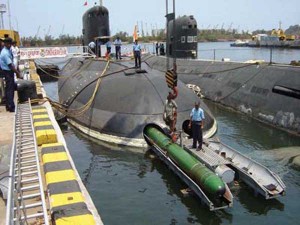 After the military reverses in the border war with China in October 1962, a major defence review was initiated to remedy the inadequacies. This gave the Navy the opportunity to resubmit its case for the acquisition of submarines.12 In addition to the arguments used earlier, it was emphasised that China possessed submarines, some of which had sufficient range to operate in the Bay of Bengal. The Navy therefore needed to acquire submarines, not only for the earlier reasons, but also for employment in the Hunter-Killer role against Chinese submarines.
After the military reverses in the border war with China in October 1962, a major defence review was initiated to remedy the inadequacies. This gave the Navy the opportunity to resubmit its case for the acquisition of submarines.12 In addition to the arguments used earlier, it was emphasised that China possessed submarines, some of which had sufficient range to operate in the Bay of Bengal. The Navy therefore needed to acquire submarines, not only for the earlier reasons, but also for employment in the Hunter-Killer role against Chinese submarines.
The new proposal put up in November 1962 asked for three submarines. The justification given was that to keep one submarine continuously on patrol in an area about 1500 miles from India, such as the Malacca Straits, three submarines would be required: one would be undergoing repairs or refit or resting the crew, the second in transit to and from the patrol area and the third actually on patrol.
Vice Admiral BS Soman (former Chief of the Naval Staff in 1963) says, “A serious bone of contention with the Government was the acquisition of submarines. I was convinced that these were crucial for a balanced force, but Prime Minister Nehru and Admiral Mountbatten thought otherwise. After a lot of discussion, I was allowed to raise the matter with the Admiralty when I went to Britain in 1963. As expected, they turned it down – it was clear that the British would only sell us vessels which conformed to their Commonwealth Indian Ocean Defence Plan. This was not acceptable to the Navy and I recommended that we look elsewhere, suggesting that Russia might be a likely substitute. We found the Russians not only ready to sell, but to accept part of the payment in rupees. Thus it came about that the Russians got our custom and remained our major and reliable suppliers over the years.”13
In 1965, a combination of events precipitated India’s decision to acquire the ships and submarines that Russia had offered in 1964, the acceptance of which had been kept pending. The Navy too had been different, and reluctant, to sever its connection with the Royal Navy and wanted to await Britain’s final decision regarding financial assistance for constructing in Britain an Oberon class submarine identical to those being built for the Royal Navy. The Oberon design was the latest at that time. In September 1965, an accord was signed by India and Russia for the acquisition of four submarines, a submarine depot ship, five Petya class submarine chasers, two Landing Ship Tanks and five patrol boats.
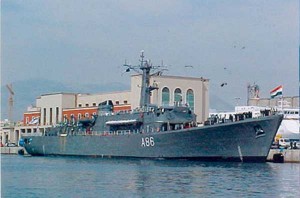 It came from what was then a non-traditional source – the Soviet Union. In fact it was the purchase of submarines that marked the beginning of a long and fruitful co-operation with the nation in the naval sphere. On 08 Dec 67, the ‘F’ class submarine INS Kalvari was commissioned. She was followed in the next few years by Karanj, Khanderi and Kursura. Then came the ‘mother ship’, a submarine support vessel called Amba. The unit was virtually complete with the arrival of a submarine rescue ship, INS Nistar in 1972.
It came from what was then a non-traditional source – the Soviet Union. In fact it was the purchase of submarines that marked the beginning of a long and fruitful co-operation with the nation in the naval sphere. On 08 Dec 67, the ‘F’ class submarine INS Kalvari was commissioned. She was followed in the next few years by Karanj, Khanderi and Kursura. Then came the ‘mother ship’, a submarine support vessel called Amba. The unit was virtually complete with the arrival of a submarine rescue ship, INS Nistar in 1972.
INS Amba, a submarine depot ship, was commissioned in 1968. Submarines, due to their inherent space limitations have to depend upon a mother or depot ship for essential supplies and certain basic facilities. These include the charging of submarine batteries, provision of high pressure compressed air, dedicated workshop facilities and accommodation for submarine crew.
Bibliography
- Singh, Rear Adm Satyindra, Under Two Ensigns, The Indian Navy 1945-50, Oxford & IBH Publishing Co., New Delhi, 1986.
- Singh, Rear Adm Satyindra, Blue Print to Blue Water, The Indian Navy 1951-65, Lancer International, New Delhi, 1992.
- The Indian Navy: An Illustrated History, Directorate of Naval Operations, Naval Headquarters, New Delhi, 1989.
- Verma, Capt Bharat, Vice Adm GM Hiranandani, Indian Armed Forces, Lancer Publishers, New Delhi, 2008.
- Vice Adm GM Hiranandani, Transition to Eminence: Indian Navy 1965-75, Directorate of Naval Operations, Naval Headquarters, New Delhi, 1989.
- Vice Adm GM Hiranandani, Transition to Triumph: Indian Navy 1975-90, Directorate of Naval Operations, Naval Headquarters, New Delhi, 1989.
- Jane’s Fighting Ships, 1972, 1973, 1974.
Notes
- Lall, KB, ‘Indian Navy’s Submarine Arm’, pp.13, Birla Institute of Scientific Research, New Delhi, 1982.
- Sound of Silence:- Forty Glorious Years of the Indian Navy’s Submarine Arm , pp.9
- Singh, Rear Adm Satyindra, Blue Print to Blue Water, The Indian Navy 1951–65 , pp.64
- Naval Plan which quoted by Vice Adm Mihir K Roy in his book ‘War in the Indian Ocean’, Lancer Publishers, New Delhi, 1995, pp57.
- Adm AK Chatterji was the former Chief of the Naval Staff in 1966. See preface’ Indian Navy’s Submarine Arm’.
- ibid.
- Hiranandani, Vice Adm GM, ‘Transition to Triumph’, Lancer Publication, New Delhi.
- ibid, pp.89. Hiranandani, Vice Adm GM, ‘Transition to Triumph’, Lancer Publication, New Delhi.
- Chatterji, Adm AK, ‘Indian Navy’s Submarine Arm’, Birla Institute of scientific Research, New Delhi, 1982.
- ibid, pp 228.
- Ibid, pp 228.
- ibid.
- Quarterdeck, the Indian Naval Magazine, Published by NHQ, 1997.




